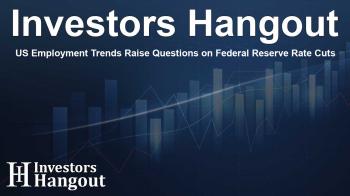US Employment Trends Raise Questions on Federal Reserve Rate Cuts

Significant US Jobs Report Impacts Federal Reserve Decisions
The latest jobs report has surprised many analysts by showing a significant increase in nonfarm payrolls, challenging forecasts and indicating that a Federal Reserve rate cut may not occur before the upcoming months. Despite calls for immediate cuts from various quarters, there appears to be a growing sense of caution among Fed members as they navigate uncertain economic waters.
Stronger Job Growth Identified
According to the recent jobs data, nonfarm payrolls have surged by 147,000, surpassing expectations that were set at approximately 106,000, with an additional 16,000 jobs added via revisions from previous months. This propelled the unemployment rate down to 4.1%, a drop from the anticipated increase to 4.3%.
While President Trump's administration has advocated for aggressive rate cuts, with suggestions from certain Federal Reserve appointees supporting immediate action, the broader consensus hinges on stable economic indicators. Analysts note that the incoming data offers little justification for changing interest rates before a more comprehensive assessment is conducted in the fall.
Examining the Nuances of Job Creation
Delving deeper into the report reveals nuances that might cloud the optimistic headlines. Private payroll additions were limited to just 74,000, contrasted against a hope for a 100,000 increase, while government roles saw a more robust 73,000 rise. Most of these new positions stemmed from state and local government jobs, along with modest growth in the leisure and hospitality sectors.
This raises concerns that traditional industries typically associated with strong economic health are not generating jobs, which is vital for sustained recovery. Additionally, wage growth remained muted at a 0.2% month-over-month increase, hinting at potential weaknesses in consumer spending power.
Potential Challenges Ahead
Looking forward, there is speculation that sectors carrying the job growth now may soon become less supportive of employment stability. The healthcare sector, particularly influenced by government spending adjustments proposed in recent policies, may face cutbacks, affecting service and education-oriented jobs.
If consumer sentiment continues to decline, the discretionary spending seen in the hospitality sector and similar areas may falter—typically the first to feel the impact during economic slowdowns. Adding to the complexity, warnings of potential layoffs have started to surface as companies prepare for uncertain economic conditions.
FOMC's Cautious Approach to Rate Cuts
The Federal Reserve, representing a cautious approach, awaits clarity on inflationary trends before committing to rate cuts. Recent statements from Fed Chair Jerome Powell emphasize a wait-and-see strategy as policymakers assess the overall economic landscape.
The current market sentiment suggests a shift in anticipated Fed actions, with previous expectations of 67 basis points in rate cuts dialing back to 53 in light of new analysis. Projections hint that if current trends continue, 50 basis points may be a reasonable estimate for cuts in the fourth quarter, with a potential further adjustment in 2026.
Frequently Asked Questions
What significance does the recent US jobs report hold?
The June jobs report indicates stronger payroll growth, suggesting possible economic stability but highlighting sector-specific weaknesses.
How might Federal Reserve decisions change moving forward?
The Fed remains cautious, looking for clearer economic guidance before making any decisions on rate cuts, especially in light of inflation concerns.
What are the implications of rising jobless claims?
Rising jobless claims could signal future layoffs, reflecting a more cautious economic environment that might affect job growth across various sectors.
Will consumer sentiment impact employment trends?
Yes, declining consumer confidence can lead to reduced discretionary spending, affecting industries such as leisure and hospitality that rely on consumer disposable income.
Is there a forecast for Federal Reserve rate adjustments?
Market insights suggest potential rate cuts may occur in the fourth quarter and into 2026, contingent upon labor market conditions and inflation pressures.
About The Author
Contact Evelyn Baker privately here. Or send an email with ATTN: Evelyn Baker as the subject to contact@investorshangout.com.
About Investors Hangout
Investors Hangout is a leading online stock forum for financial discussion and learning, offering a wide range of free tools and resources. It draws in traders of all levels, who exchange market knowledge, investigate trading tactics, and keep an eye on industry developments in real time. Featuring financial articles, stock message boards, quotes, charts, company profiles, and live news updates. Through cooperative learning and a wealth of informational resources, it helps users from novices creating their first portfolios to experts honing their techniques. Join Investors Hangout today: https://investorshangout.com/
The content of this article is based on factual, publicly available information and does not represent legal, financial, or investment advice. Investors Hangout does not offer financial advice, and the author is not a licensed financial advisor. Consult a qualified advisor before making any financial or investment decisions based on this article. This article should not be considered advice to purchase, sell, or hold any securities or other investments. If any of the material provided here is inaccurate, please contact us for corrections.

